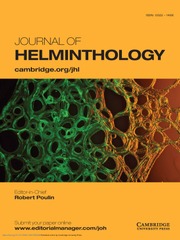No CrossRef data available.
Article contents
First molecular characterisation of a species of Pharyngodon Diesing, 1861 (Nematoda: Pharyngodonidae), and description of Pharyngodon ameivulum n. sp. in a lizard from Caatinga in Brazil
Published online by Cambridge University Press: 14 February 2025
Abstract
This study describes a new species of Pharyngodon Diesing, 1961 (Nematoda: Pharyngodonidae) in teiid lizards Ameivula ocellifera (Spix, 1895) (Squamata: Teiidae) from a Caatinga morphoclimatic domain in the state of Pernambuco, Brazil. Pharyngodon ameivulum n. sp., like 11 other species of the genus, features males without spicules, females with truncated eggs, and no tail spines. However, the new species is distinguished by a unique set of morphological characteristics, such as males possessing three pairs of caudal papillae, with the first pair precloacal, the second adcloacal, and the third postcloacal (arrangement 1:1:1), the second pair (adcloacal) of papillae having a bifurcated distal end, and females with lateral body alae. Molecular analysis of the 18S rDNA, 28S rDNA, and 18S + 28S concatenated sequences genes reveals that P. ameivulum n. sp. clusters with representatives of Pharyngodonidae from the genera Skrjabinodon Inglis, 1968 and Spauligodon Skrjabin, Schikhobalova & Lagodovska, 1960, forming a basal clade to the clade composed of Spauligodon spp. and Skrjabinodon trimorphi Ainsworth, 1990. These are the first phylogenetic assays to include a species of Pharyngodon.
- Type
- Research Paper
- Information
- Copyright
- © The Author(s), 2025. Published by Cambridge University Press


